 |
Close
window to return
|
Issue 2, July 1998, pp.12-14.
Changing health of women in England: 1984-1993
Mel Bartley and Amanda Sacker
Introduction
Social class differences in mortality among women increased during the
1980s, despite general improvements in health and longevity. Death rates
fell in all social classes, but the decrease was 22% among those in higher
professional and managerial households and only 6% in women in non-skilled
manual households.(1) At the same time, women's domestic lives and occupational
roles have changed. More women are now living alone, lone parenthood is
more common and more married women are going out to work. Despite greater
employment opportunities for women, many are still concentrated in clerical
and sales jobs or in semi-skilled and unskilled manual work.
Measuring health and social position
In this first report from our study, we looked at ill-health, rather than
mortality, and asked whether health inequalities have changed for women
in the 1980s and 1990s as a result of changes in their domestic and employment
circumstances.
It was possible to do this because two similar health surveys were done
about ten years apart: the 1984 Health and Lifestyle Study (HALS) and
the 1993 Health Survey for England (HSFE). Both of these asked about women's
(and men's) employment, marital and family situations as well as their
health. Women in poor health were identified according to their response
to a survey question 'how is your health in general?' The answer to this
rather vague sounding question, usually referred to as 'general self-rated
health' has been found in many other studies to be a good predictor of
later heart disease and other causes of mortality.
Our study took a measure of social position which is widely used in the
UK to study things like voting and political beliefs, but which has not
yet been used very much in health studies. Because nowadays we think of
health as being importantly influenced by people's ideas, attitudes and
behaviour, it is useful to have a measure of social position which is
known to be related to these aspects of life. The Erikson-Goldthorpe (E-G)
system classifies occupations into social classes according to the conditions
and relationships which people in each job typically experience: for example
the amount of job security they have, whether or not there is a career
structure with pay rises each year and chances for promotion, and how
much autonomy a person has over their own working time. There is strong
research evidence from other studies that job security and autonomy are
related to health. E-G classes range from professionals and managers in
Class 1 to non-skilled manual workers in Class 5.
Women were also classified according to their domestic roles and how they
divided their time between home and paid work: either working full-time,
working part-time or keeping house. Parental status was split into those
with and without children under 16 years living in the household. The
changes in the proportions of women in different combinations of social
roles between 1984 and 1993 can be seen in Table 1.
Findings so far: widening inequalities
There has been no decline in the scale of health inequality in women between
the 1980s and 1990s. After taking account of age, women in (or previously
in) non-skilled manual occupations were over twice as likely to report
that their health was less than good than women in professional occupations
in 1984. The same comparison in 1993 showed that the gap had widened further:
women in the non-skilled manual class were nearly three times more likely
than women in the professional class to be in poor health. This inequality
in women's health remained, even after differences in occupational and
domestic roles were taken into account. In 1984, after adjusting for differences
between women in professional and non-skilled manual work in terms of
their social roles (employment, marital and parental status), professional
women were still half as likely to have poor health as women in non-skilled
manual work. In 1993, the likelihood of poor health for women in non-skilled
manual work reduced from 2.7 times to 2.3 times that for professional
women before and after taking these factors into account.
Even though social roles explain a lot of the differences in health between
women, they clearly do not explain why women in different occupational
classes had more or less ill-health. Moreover, despite the marked increase
in employment amongst women between 1984 and 1993 (see Table 1), the social
gradient in health, that is, health differences according to occupational
class, had not decreased.
Table 1: Distribution of variables (percentages) for women aged 20
to 59 in the Health Survey for England (HSFE) and the Health and Lifestyle
Survey (HALS).
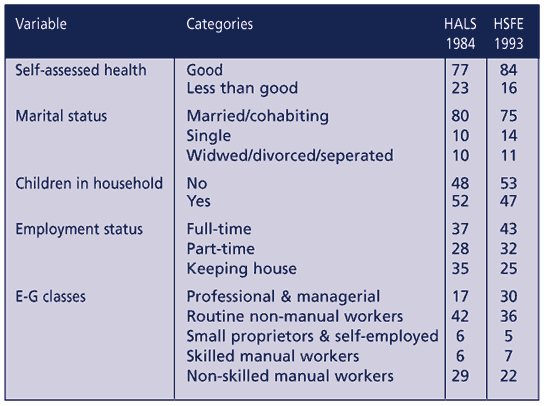
The influence of
children, employment and marital status
But what happened to health differences between women in different social
roles? Work and children affected women differently in the 1980s and 1990s.
Women without children at home and in full-time paid employment had better
health than those remaining at home, with part-time workers holding an
intermediate position. However, women without childcare responsibilities
who had no paid work tended to have worse self-rated health than their
working counterparts in 1993 than in 1984 (see Figure 1). For women with
children, a different trend could be seen. In 1984, women with children
at home had the best health if they were working part-time, with higher
rates of poor health reported by women in full-time work or keeping house.
In 1993, working full-time with children was associated with having the
poorest health whilst women remaining at home with their children had
the best health.
The health of women was also affected by marital status, particularly
for those who had no paid jobs. Married women had the best health overall.
But in 1984, single women without paid work were nearly 5 times as likely
to have poor health as married women working full-time, with previously
married women close behind (see Figure 2). In 1993, the health gap between
single women without paid work and working married women was smaller than
it had been in 1984, but divorced, widowed or separated women without
paid employment remained far less healthy than those with both jobs and
partners/husbands.
Figure 1: Relative risk for poor self-assessed health by employment
status and maternal status
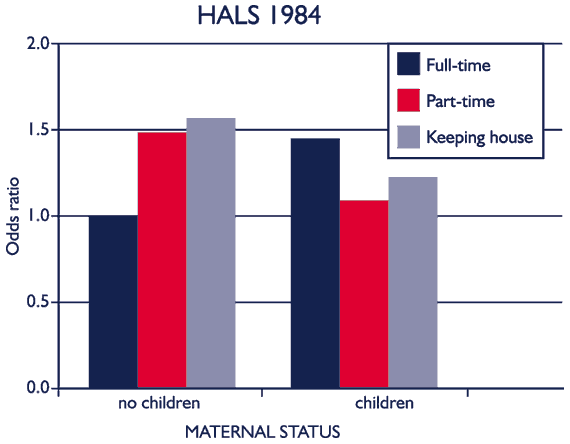
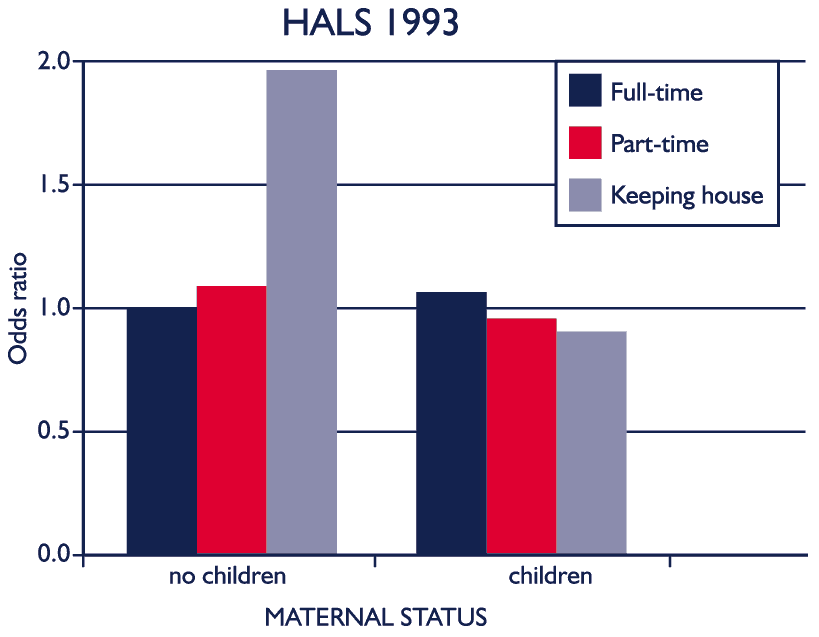
Women at risk of poor health
By looking at each combination of social roles in the two time-periods,
we identified a group of women who may be particularly at risk for poor
health in the 1990s.
This conclusion was reached on the basis of a statistical model, but it
can be illustrated by drawing a picture of a 'typical' member of the group.
It would be accurate to imagine her as having been out of the labour market
for many years while her children grew up and then finding herself without
the resources to return to work once on her own through divorce or widowhood.
Whilst there may have been many women in this position in the 1980s, the
expectation in the 1990s is that women on their own will seek work. However,
women who were over 45 or 50 in 1993 were too old to have benefited fully
from the changes in education and law which reduced the level of discrimination
against women who wished to acquire skills. Those who, for this reason,
are without up-to-date occupational skills may be increasingly disadvantaged
in today's labour market when competing against younger people for work.
In the 1993 survey we used in our study, only 6% of previously married
women without children at home remained non-employed if they had at least
GCSE level qualifications compared with 23% of those with no qualifications.
Against prevailing trends towards better health in the 1990s, the health
of this small group has remained poor, with 54% reporting poor health
in both surveys.
Figure 2: Relative risk for poor self-assessed health by employment
status and marital status
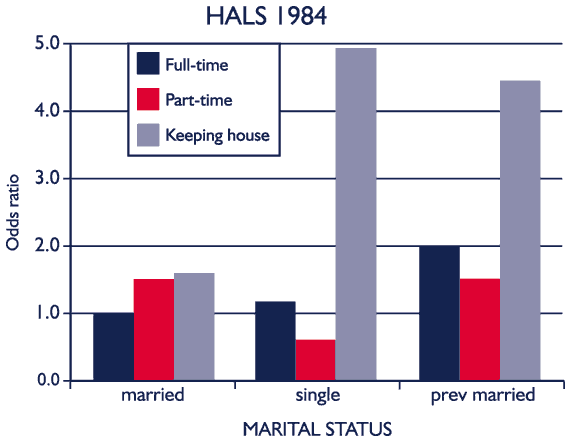
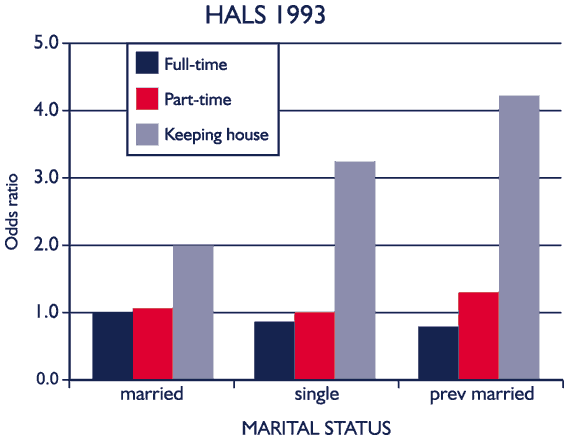
Conclusions
It is clear from these results that social position defined in terms of
employment relations and conditions is related to health, and this inequality
is largely unaffected when other aspects of women 's lives are also considered.
However, the contribution of domestic roles and occupational characteristics
is complex. It has significantly changed over the period 1984-1993 in
ways which need to be understood in the context of rapid changes in the
opportunities and expectations of women. In particular, the evidence would
seem to point to the particular vulnerability of older women without work,
as a group who are at greatest disadvantage in terms of health in the
1990s.
Mel Bartley and Amanda Sacker both work in the Department of Epidemiology,
University College, London, and run the project in the Health Variations
Programme on 'Social variation in women's health: work or way of life'.
Mel Bartley is also a member of the project team for 'Dimensions of health
variations over persons, time and place.'
Reference:
1. Drever, F. and Whitehead, M. (eds.) (1997) Health Inequalities:
Decennial Supplement, London : The Stationery Office.